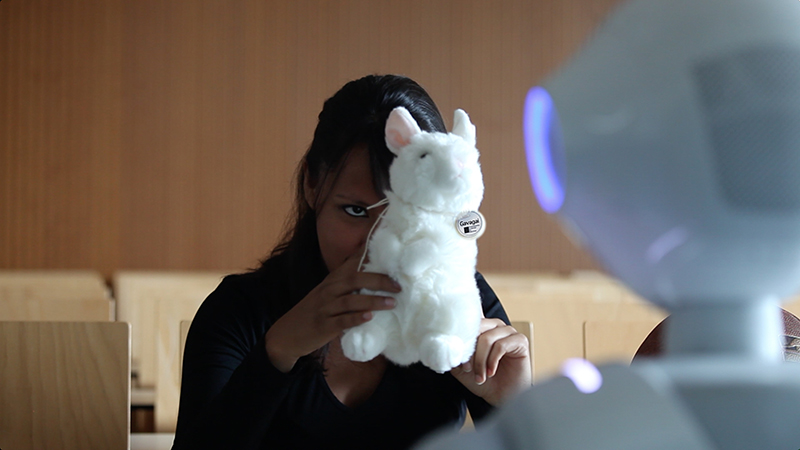The project “MAKE ROBOTS TALK” is project nr. 5 under the Spinoza project “Understanding Language by Machines” > Communicative robots: the Leolani Principles
Visit http://makerobotstalk.nl
“Our communicative robot Leolani is driven by curiosity and the need for social contact. Meet her and become one of her many friends. She wants to know all about you, never stops asking questions (unless you ask her to stop), remembers all you said and learns from you about you and about the world.”
Why a communicative robot?
People make mistakes but robots too. To collaborate, humans and machines need to solve problems together, recognising each other’s weaknesses and limitations and exploiting their strengths. This requires communication in human language and not for people to debug a machine in a program language such as Python.
Robots see the world differently than humans. To prevent misunderstandings, robots need to communicate in a transparent and honest way. Because people often think robots are like humans, robots need to detect when there is a misunderstanding and explain differences.
Machines still need to learn a lot about the world but also about us, the people they serve. By means of communication through language, a robot can get feedback and efficiently learn from humans, in the same way as we teach our children not only through experience but also by instructions that explain things.
By talking, a robot gets to know her human partners: who are we, what do we do, who are our friends and family, what we like and what we don’t like. It is way easier to communicate with acquaintances and friends whose background you know and with whom you share a past than with strangers.
It is much nicer and comfortable to work together with a robot that understands you, recognises your mood and state of mind and is always willing to listen.
Our robot learns through communication and stores the result in a ‘brain’. She use her brain to communicate better and more efficient and to understand situations she encounters. Ultimately, we develop robots that adapt to situations and to you, so that communication and collaboration are more smooth and efficient, with less errors.
The robot communicates in natural language for the following purposes:
- learn about the world (what is ‘speculaas’) and about you (what do you like, who is your family)
- teach you something about the world (how high is the Eiffel tower, I found a recipe for ‘speculaas’)
- in case of confusion, reach understanding, explain the cause of misunderstanding
correct the robot and correct humans in case of errors - resolve uncertainties (I have imprecise information, I could not hear you)
- resolve conflicts if information is incompatible (but you said something else than your friend)
- negotiate about right or wrong (go outside or stay inside when it may snow)
- give warnings if the robot sees or knows something you do not (watch out the floor is slippery, your sister’s birthday, you forgot a pill)
- stimulate activity (let’s walk), social contact (your grand child just posted she got her diploma), brain gymnastics (I have a riddle for you).
- get help from others and experts when needed
- always answer questions and requests, always patient and polite
- company, comfort and entertainment (tell a joke)
LEOLANI HAS HER OWN WEBSITE: WWW.MAKEROBOTSTALK.NL
Lecture (in Dutch) Prof. dr. Piek Vossen at Paradiso Amsterdam: ‘To Communicate with an Imperfect Robot — Get It?’ March 25, 2018
Impression of ‘Talking with robots’ — Workshop Weekend of Science, October 7 2017

